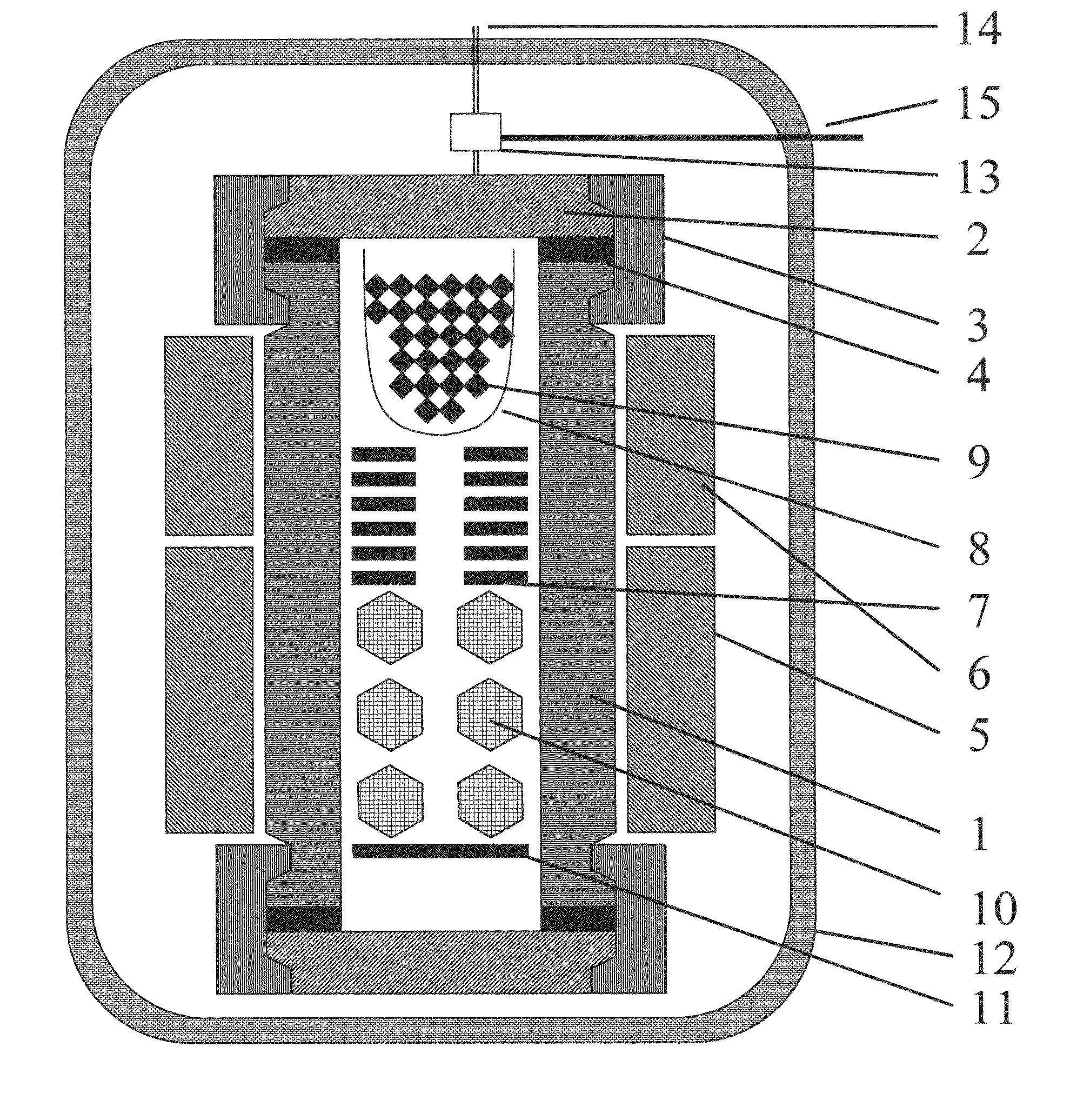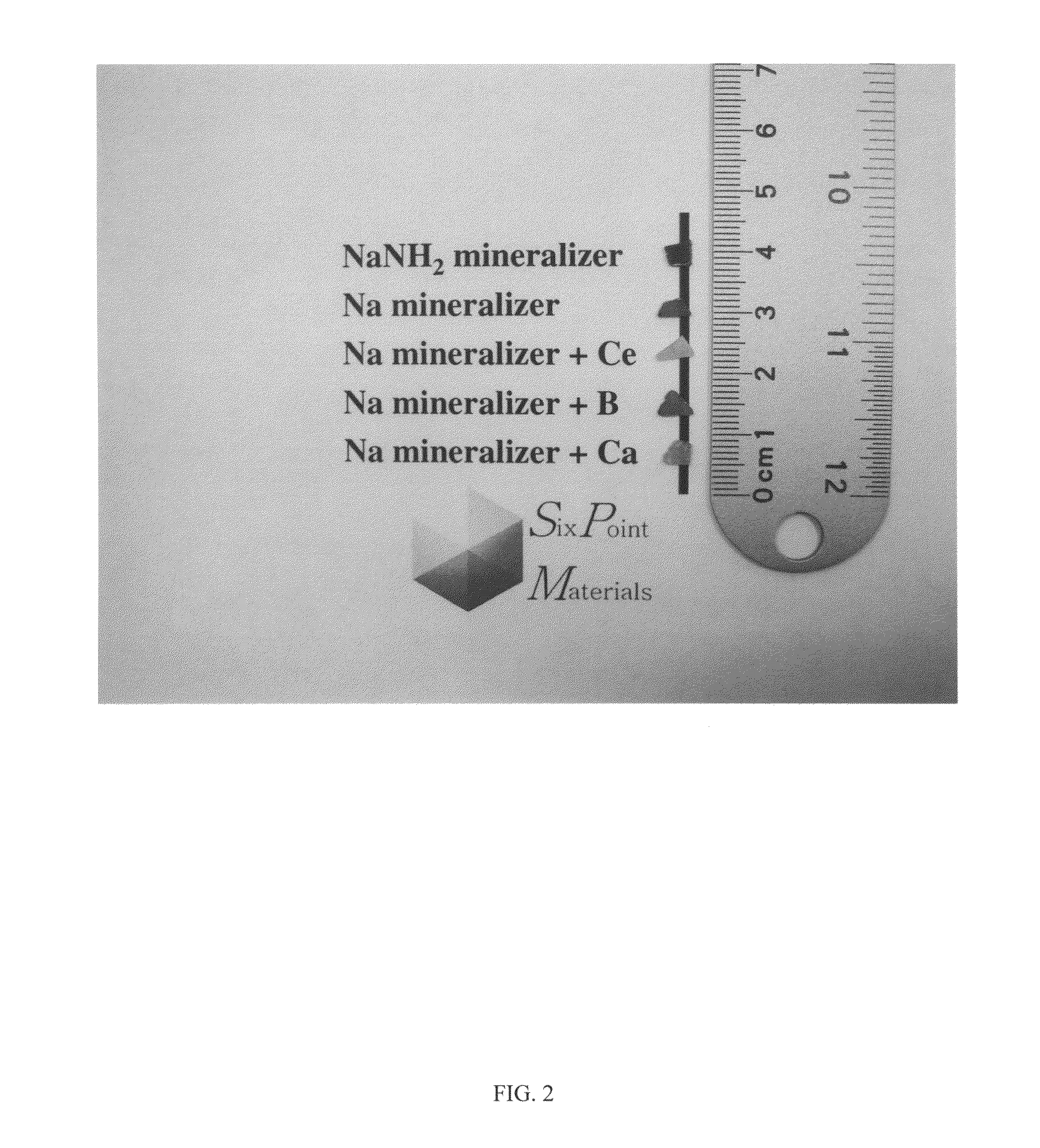High-pressure vessel for growing group III nitride crystals and method of growing group III nitride crystals using high-pressure vessel and group III nitride crystal
a technology of nitride crystals and high-pressure vessels, which is applied in the direction of crystal growth process, polycrystalline material growth, transportation and packaging, etc., can solve the problems of difficult to grow gan crystal ingots, disadvantages in expanding the reactor scale, and affecting the realization of high-end optical and electronic devices, so as to reduce the parasitic deposition of polycrystalline gan, improve structural quality, and improve the effect of structure quality
- Summary
- Abstract
- Description
- Claims
- Application Information
AI Technical Summary
Benefits of technology
Problems solved by technology
Method used
Image
Examples
example 1
[0077]To solve the above-mentioned problem, a few methods to obtain larger clamps were sought and we discovered it possible to manufacture a large diameter disk with e.g. precipitation hardenable Ni—Cr based superalloy or other metal or alloy by forging as-cast billet along longitudinal direction. With this method, a 17-inch as-cast billet is forged along the longitudinal direction to form a 20-inch diameter, 1-foot thick disk. The forging process usually creates a directional microstructure (grain flow) which determines tensile strength of the material.
[0078]The grain flow of the round rod to construct the body and lids is typically along the longitudinal direction whereas the grain flow of the disks to construct the clamps is along the radial direction. While one might expect a disk with radial grain flow rather than axial grain flow to not have sufficient tensile strength to reliably clamp a lid to a reactor body during use, this difference does not have a significant impact on t...
example 2
[0085]Another method to realize a large diameter high-pressure vessel is to use high-strength steel for the clamp material. Although the maximum practical temperature for high-strength steel (such as 4140) is 550° C., the maximum available size is large enough to fabricate clamps for high-pressure vessel having 12-inch outer diameter. In this case extra caution is necessary to control the clamp temperature. An end region in the reactor that has one or more baffles to impede ammonia flow permits ammonia to cool in an end region, reducing the reactor temperature in that region and allowing a clamp to be formed of a material such as high strength steel that might not otherwise be used to form a clamp. Also, appropriate anti-corrosion coating is advisable in case of ammonia leak since steel is susceptible to corrosion by basic ammonia.
example 3
[0086]In this example, a high-pressure vessel having an inner diameter of 1 inch was used to demonstrate the enhanced growth rate by having one or more buffer regions between the crystallization region and the nutrient region. Unlike the Examples 1, 2, this high-pressure vessel has an open end on one side only. The chamber of the high-pressure vessel is divided into several regions. From bottom to top, there were a crystallization region, buffer regions, and a nutrient region. GaN crystals were grown with 2 buffer regions, 5 buffer regions, and 8 buffer regions and the growth rate in each condition was compared. First, the high-pressure vessel was loaded with 4 g of NaNH2, a seed crystal suspended from a flow-restricting baffle having 55 mm-long legs (the first baffle). To create buffer regions, 2 flow restricting baffles with 18 mm legs, 5 flow restricting baffles with 18 mm legs or 8 flow restricting baffles with 10 mm legs were set on top of the first baffle (i.e. buffer regions ...
PUM
| Property | Measurement | Unit |
|---|---|---|
| inner diameter | aaaaa | aaaaa |
| inner diameter | aaaaa | aaaaa |
| temperature | aaaaa | aaaaa |
Abstract
Description
Claims
Application Information
 Login to View More
Login to View More - R&D
- Intellectual Property
- Life Sciences
- Materials
- Tech Scout
- Unparalleled Data Quality
- Higher Quality Content
- 60% Fewer Hallucinations
Browse by: Latest US Patents, China's latest patents, Technical Efficacy Thesaurus, Application Domain, Technology Topic, Popular Technical Reports.
© 2025 PatSnap. All rights reserved.Legal|Privacy policy|Modern Slavery Act Transparency Statement|Sitemap|About US| Contact US: help@patsnap.com



